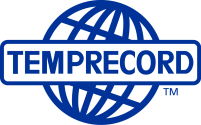If you are new to Temprecord, this topic provides a step-by-step tutorial on how to use a data logger to record temperature and then reading and displaying the recorded temperature data. The following steps assume you have just taken delivery of a ‘starter pack’ consisting of the Temprecord program Temprecord for Windows Software, a Temprecord Cryogenic, Medical, Multi-trip or Scientific data logger, and a Temprecord Reader Interface.
- Connect the Temprecord Reader Interface to your computer’s USB port.
- You need to plug it into a USB port. These are normally located on the rear of the desktop PCs, or on the side or rear of laptop/notebook PC's.
- Warning: Unplugging the USB reader interface from the computer's USB port while Temprecord is running can have unpredictable effects and result in the loss of communication with the logger. It is best to exit Temprecord before unplugging or plugging in the reader interface.
- Insert the Temprecord logger into the Reader, making sure it is pushed all the way in and the retaining hole is visible.
- Select File/Query Logger by opening the File Menu and clicking on Query Logger. After a few seconds, a window should display showing a summary of the logger.
- Select Program/Parameters. After a few seconds you will see the Logger Parameters screen, which allows you to set the logger up. Change the sample period to 00:00:10 (one sample every 10 seconds). Set the start delay to 00:00:20 (20 seconds).
- Click on ‘OK’. After a few seconds the logger parameters screen will close.
- When the logger parameters’ screen has closed, remove the logger from the reader interface. The logger will flash the green LED every ten seconds to indicate the start delay is counting down. When the start delay has counted down to zero, the logger will flash the red LED four times in quick succession and take the first sample, and the LEDs from that point will then flash every ten seconds to indicate the state of the limits (a brief green flash for inside the upper and lower limits, a red flash for outside the limits). On the LCD logger this behaviour is configurable - i.e., when you program a logger, you can determine whether the LEDs indicate the state of the limits.
- Place the logger in an environment you wish to measure the temperature of (e.g., a refrigerator) and leave it for a few minutes.
- Retrieve the logger, and insert it into the Reader Interface.
- Select the File/Read Logger function. A window will open indicating the data is being read from the logger. When this step is complete a graph of the recorded samples will display.
- Select the View/Values function. The Window will change to display the logged temperatures as a series of temperature values.
- Select the File/Save function. This allows you to save the logged temperatures to a file so that they can be read from disk later. Temprecord initially chooses a filename based on the serial number of the logger, but you are free to change this if you wish.
- Click on OK to save the data to disk.
| Your Temprecord logger continues to record samples until it is stopped or the maximum number of samples is taken (unless the Loop Overwrite Option is turned on). You do not need to stop the logger in order to read and display the logged temperature. | |
| On the LCD logger the behaviour of the LEDs when limits are transgressed is configurable - i.e., when you program a logger, you can determine whether the LEDs indicate the state of the limits. See Enable Status LEDs for more information. |
Congratulations! You have just used your Temprecord logger to record and display temperature samples. Temprecord software for calibrated loggers

